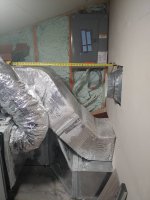No. In general equipment can require examination while energized during troubleshooting, for example measuring voltages. If you ever have to trouble shoot the individual circuits in the combiner it would be the same thing.
the panel is just acting like a junction box, it never needs any attention, according to manufacturer it can be replaced by a junction box, if I can show that this is ana optional extra safety that we put in so we dont have to bring all the wires to the main panel that should fit
" does not require
examination, adjustment, servicing, or maintenance while energized " per NEC.
Inspector correct, the combiner is not just a jbox that get all the wires brought into. The presence of the overload protection require access and clearance of any other breaker panel.
The 12" reference in the instructions is in reference only the minimum hight off grade indoors, not clearances, in same paragraph it also states that the combiner be installed in a "readily accessible place". Your comment above "in the attic in a tight space" would be neither readily accessible or having appropriate workspace.
Just a side point, if attic is as described, it is likely not conditioned for temperature and likely will be VERY hot and VERY cold seasonally, and the breakers and electronics do not tolerate extreme conditions very well.
That isn't the concern of the inspector, if the conditions of the code are not met by current installation it fails and would need to be modified to be compliant.
Many times as installers and electricians we may neglect to review or by a simple oversight miss hitting an install correctly and need to "fix it" and how easy it is, is irrelevant to meeting code (even though might be relevant to guy doing work). I just view these as "I'll remember never do that again" moments, even though don't like it in the moment.
I think if it was me doing inspection and had to climb through an attic hatch and crawl in 2ft of blown-in to get to a panel I'd fail it too. I'm also sure a service tech that might have to come back to fix the overheated panel electronics would be none to happy laying in insulation at a 140 deg to try and service it.
I've never seen an installation done that way. Was there even signage to indicate the combiner location being other than the obvious location near the service panel? Proper signage is another potential point of failure as well. Lots and lots of signage required for a solar installation.
The panel is placed in a fully finished and Air conditioned attic , the height of the ceiling is 6.5 feet tall at the panel and it has 36" wide area to work at the level of the panel. the problem is the AC ducts below the panel level reduce that width to a bit less than 30" and reduce the heigh right infront of the panel as a 2 ducts pass on the floor. it is easily accessible otherwise with lights and air conditioning.
regardless the code is the code, black and white (almost) my only argument would be this sentence in NEC 110.26
"
require examination, adjustment, servicing, or maintenance while energized is required by installation instructions or function"
1) the Panel was optional and it functions as a combiner or Junction box
2) the panel can be fully de-energized and there is no need according to the manufacturer to work on it while energized
Hence by function and installation instruction is does not require to be energized while working on it and is exempt from those exact measurements as long as it is easily accessible.
I guess if push comes to show I will just change it to a J-Box for inspection, while less safe, it should pass inspection. I hope I dont have to do that extra work to go backward.
For Reference:
NEC 2020 110.26
(A) Working Space. Working space for equipment operating at 1000 volts, nominal, or less to ground and likely to
require examination, adjustment, servicing, or maintenance while energized shall comply with the dimensions of 110.26(A)
(1), (A)(2), (A)(3), and (A)(4) or as required or permitted elsewhere in this
Code
(4) Limited Access. Where equipment operating at 1000 volts, nominal, or less to ground and likely to
require examination, adjustment, servicing, or maintenance while energized is required by installation instructions or function to be located in a space with limited access, all of the following shall apply:”


